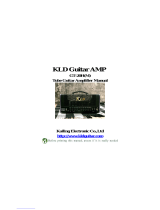
Troubleshooting
* The amp does not power-up after you have switched the power on;
the Channel & Gain Boost switching functions do not react,
i.e. the corresponding control LED's do not indicate an active function;
moreover no sound is emanating from the connected speaker.
-> Is the mains cord connected to the receptacle / live power source?
-> Is the power cable you are using intact? Try another equal mains cable.
-> Is the mains lead properly connected to the AC Power Inlet (14) at the amp?
-> Possibly the mains fuse (15) has blown, unplug the mains cord from the mains connector
and the receptacle and check the mains fuse.
* The amp fails to respond when you try to control switching functions remotely
using a footboard such as the Z-4 or a MIDI switcher such as the ENGL Z-11.
-> Are the footpedals (or the switching loops) connected to the corresponding
footswitch jacks (16, 17)?
-> Are the cords you are using stereo, intact, and wired properly?
(Refer to "Wiring of Principal Connectors" for pin assignments.)
-> If you are using footswitches other than an ENGL Z-4 or Z-11, are the switches or relays inside the
boards or switching loop systems off / on Single Pole Single Throw (SPST) switches? In other words,
do these switches continuously connect to GND when you wish to activate the given function?
If you're unsure about the answers to these questions, consult an authorized service center or a
professional specialist.
* The amp is not providing an output signal / no sound is emanating
from the speaker.
-> Is at least one speaker connected to the speaker outputs 8 ohms (23) or 16 ohms (24)?
-> Is the power amp activated (Standby switch to ON / "upper" position)?
-> Are all cords (guitar, effect, and speaker) connected properly and are they functional?
-> Unplug connected effectors and see if the preamp works fine without these peripheral devices.
-> Is the Power Soak Selector (step switch; 26) set to "Speaker Off? "
In this case, the 8-Ohm Output (23) is switched off!
Set the Power Soak Selector (26) to another position, e.g. "Full Power."
-> Are the Master, Gain or Volume knobs set to a value greater than "0" (7 o'clock)?
If any of these knobs is fully down, no signal is routed to the amp's outputs.
-> You may be looking at a faulty tube or another defect. (the internal power tube fuses blown, etc.)
In this case, be sure to take the amp to an authorized, professional service center.
* The speaker is emitting humming noises:
-> Is there a connection (for example, via a shielded circuit, e.g. Line Out) between the amp
and another device that is grounded via a power plug of its own?
Two or more circuits sharing a common electrical ground line can cause audible hum.
If low-frequency noise is emanating from your rig, be sure to consult a specialist.
-> The amp and mains grounds are not connected properly or are altogether
disconnected. Have an experienced specialist check this.
-> Cords connected to the input or effect loops may not be shielded properly.
Replace them to check if this is indeed the case.
-> The amp or speaker cords may be picking up interference from powerful
magnetic fields (for example, of nearby power transformers or electrical motors).
Reposition the amp and connector cables.
-> The amp or speaker cords may be picking up radio signals, for example,
from activated mobile telephones or powerful local transmitting stations nearby.
Switch off mobile phones while troubleshooting noise problems.
* One of the power amp's internal micro-fuses blows, so its output power
and therefore the overall volume drops dramatically:
-> The given power tube may be defective. If that power tube's internal micro-fuse is replaced
and the new fuse also blows, the defective tube needs to be swapped out. Fuses and tubes
should be checked and replaced by a qualified professional or specialist.
-> Other reasons a power amp fuse may blow: The amp has been overloaded by excessive volume
levels, mains voltage, or the wrong output impedance. Check the speakers' overall impedance and,
if necessary, adjust your setup accordingly (refer to the paragraph under
"Speaker / cabinet options" in section 25).
CAUTION! Please read and heed the following:
You'll find an ancillary pamphlet accompanying this owner's manual entitled
Instructions for the Prevention of Fire, Electrical Shock and Injury.
Be sure to read it before you plug in and power up the amp!












